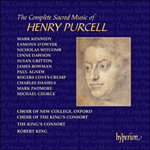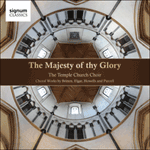The expressive, graphic, text from The Song of Solomon,
My beloved spake has been set with great originality by several British composers over the centuries (including a wonderful setting by another under-rated Englishmen, the twentieth-century composer Patrick Hadley) but no setting has been more original than that of Henry Purcell. Dating from before 1678,
My beloved spake is one of Purcell’s earliest surviving compositions: it is hard to believe that this skilfully crafted anthem could be the work of a teenager. With a text full of references to spring, it is remarkable in almost every aspect: for its freshness, its glorious string writing, its extraordinary word-painting and its novel harmonic language.
The single-section Symphony contains music of enormous originality and leads straight into the opening quartet where the coming of spring is treated with ecstatic lyricism, and the word ‘rise’ is thrown between the voices. The passing of winter and the ritornello that takes over from the voices produces more delicious discords before the arrival of the spring flowers is celebrated with a move back to the major key, a joyful quartet and a chorus at ‘the singing of birds is come’. But the most astonishing harmony is reserved for ‘And the voice of the turtle is heard in our land’ where Purcell creates one of the most extraordinary tonal shifts of the era.
The opening Symphony is repeated before the tenor, accompanied by a winding solo violin imitates the fig tree tortuously growing her green figs and the vines slowly putting forth their produce. The ecstasy of the opening returns at ‘Rise, my love, my fair one’, followed by a joyful Alleluia and the final chorus.
from notes by Robert King © 1991
Le texte graphique et expressif du Chant de Salomon
My beloved spake (‘Mon bien-aimé parla’) a été mis en musique avec beaucoup d'originalité par plusieurs compositeurs britanniques au fil des ans (parmi lesquels un merveilleux arrangement par un autre Anglais sous-estimé, le compositeur contemporain Patrick Hadley), mais aucune mise en musique n'est aussi originale que celle de Henry Purcell. Datant de 1678,
My beloved spake est une des premières compositions de Purcell qui ont survécu: il est difficile de croire que cet hymne parfaitement travaillé puisse être l'oeuvre d'un adolescent. Avec un texte rempli de références au printemps, il est remarquable sous presque tous ses aspects: pour sa fraîcheur, sa glorieuse écriture pour les cordes, son imagerie extraordinaire et son langage harmonique original. La symphonie en une seule section contient une musique d'immense originalité, et mène droit dans le quatuor d'introductionüâ, où l'arrivée des cordes est traitée avec un lyrisme extatique et le mot ‘rise’ (‘Lève-toi’) est projeté entre les voix. Le trépas de l'hiver et la ritournelle qui prend la relève des voix produisent encore d'autres dissonances délicieuses avant que l'arrivée des fleurs printanières ne soit célébrée par un retour au ton majeur, un joyeux quatuor et un choeur à ‘The singing of the birds is come’ (‘Le temps de chanter est arrivé’). Mais l'harmonie la plus surprenante est réservée à ‘And the voice of the tuéärtle is heard in our land’ (‘Et la voix de la tourterelle se fait entendre’) dans lequel Purcell exécute un des plus extraordinaires changements tonaux de l'époque. La symphonie d'introduction est répétée avant que le ténor, accompagné par un violon solo sinueux n'imite la tortueuse poussée des figues vertes sur le figuier et la lente maturité des raisins sur les vignes. L'extase du début revient à ‘Rise, my love, my fair one’ (‘Lève-toi, mon amie, ma belle’) suivi d'un joyeux alléluia et du choeur final.
extrait des notes rédigées par Robert King © 1991
Français: Alain Midoux
My beloved spake, der expressiv anschauliche Text nach dem Hohelied Salomos, ist im Laufe der Jahrhunderte von mehreren britischen Komponisten mit großer Originalität vertont worden (darunter die wunderbare Bearbeitung eines anderen unterbewerteten Engländers, des Gegenwartskomponisten Patrick Hadley), aber keine Vertonung ist so originell wie die von Henry Purcell. Mit einem Entstehungsdatum vor 167 ist
My beloved spake eine der frühesten erhaltenen Kompositionen Purcells. Dabei ist kaum zu glauben, daß dieses gekonnt gestaltete Anthem das Werk eines Jugendlichen gewesen sein soll. Der Text steckt voller Anspielungen auf den Frühling, und das ganze Werk ist in fast jeder Hinsicht bemerkenswert: Wegen seiner Frische, seiner herrlichen Streicherführung, seiner außergewöhnlichen Klangmalerei und seiner neuartigen Harmonik. Die einteilige Sinfonia enthält Musik von großem Einfallsreichtum und geht direkt in das Eröffnungsquartett über, das den bevorstehenden Frühling ekstatisch lyrisch abhandelt, wobei das Wort ‘rise’ [erhebe dich] immer wieder zwischen die Stimmen eingestreut wird. Das Ausklingen des Winters und das Ritornell, das sich an die Gesangspassage anschließt, bringen weitere köstliche Dissonanzen hervor, ehe die Ankunft des Frühlings und seiner Blumen mit einer Rückkehr in die Durtonart, einem freudigen Quartett und einem Chor bei ‘the singing of birds is come’ gefeiert wird. Doch die verblüffendste Harmonik ist den Worten ‘And the voice of the turtle is heard in our land’ vorbehalten, bei denen Purcell eine der außergewöhnlichsten Akkordverschiebungen der Epoche gelingt. Die einleitende Sinfonia wird wiederholt, und dann imitiert der Tenor, begleitet von einem gewundenen Soloviolinpart, den Feigenbaum, der umständlich seine grünen Feigen wachsen läßt, und die Rebstöcke, an denen langsam die Früchte hervortreten. Die Ekstase der Eröffnung setzt bei ‘Rise my love, my fair one’ wieder ein, gefolgt von einem frohlockenden Alleluja und dem Schlußchor.
aus dem Begleittext von Robert King © 1991
Deutsch: Anne Steeb/Bernd Müller


 Purcell: The Complete Sacred Music
Purcell: The Complete Sacred Music The Majesty of thy Glory
The Majesty of thy Glory
